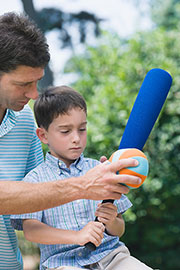By Marina Sarris, Interactive Autism Network, 20 June 2018 https://iancommunity.org/ssc/autism-physical-fitness
The core features of autism – social, communication and behavior problems – can make joining a game of kickball at recess or playing tag with neighborhood kids a struggle. What may be less well known, however, is that many people with autism spectrum disorder (ASD) also face problems with motor (muscle) skills, including balance and coordination.
Motor skills also involve planning – knowing what you want your body to do and coordinating your movements to do it. Before you pick up a ball, you plan to bend down, grab the ball between your hands, bring it to your chest and straighten your body. And of course, you must maintain your balance while you do that. Some researchers have gone as far as to suggest that motor planning problems, or dyspraxia, may be a “core deficit” of autism or a sign of the nervous system abnormalities behind autism.
In addition to below-average motor skills, many people with autism may have other problems that keep them from getting enough exercise, joining a soccer league or playing pick-up basketball in the neighborhood. Safety can be one such barrier. According to research by the Interactive Autism Network, nearly half of children with autism spectrum disorders wander or run away, and half of those go missing. Parents and caregivers may keep a child who wanders indoors more often to protect him or her.
Safety isn’t the only barrier to sports and recreation; sometimes understanding the rules and social conventions of games can keep a child with autism from participating.
Many children on the spectrum find certain sports to be emotionally and socially taxing because they involve following complex rules, waiting your turn to play or get the ball, and interacting with many children all at once.
Most children learn the ins and outs of sports, from high-fives to the offside rule of soccer, in physical education class. But these often noisy, crowded classes may make children with sensory and social problems miserable. And it can be hard to get individual instruction with 30 or more other children in the class.
Parents also can ask the child’s special education team about occupational and physical therapy in school. Occupational therapists work on fine motor skills, those involving the small muscles used to grasp pencils or utensils. They also may help people adapt to sensory challenges that interfere with school or daily activities. Physical therapists address gross motor skills, which involve the large muscles used to walk, run and jump.
This article address the challenges of physical fitness for children with Autism. In addition to motor skill challenges, this article discusses other barriers to physical fitness like safety and emotional challenges for children with Autism.




